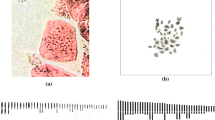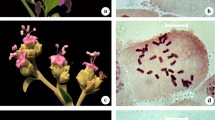Abstract
Chromosomal analysis of 33 species of Labiatae from South India have indicated that 23·53% are polyploids. Several taxa are investigated for the first time. Analysis of results in totality for the region indicates that shrubby and perennial species have higher incidence of polyploidy. Polybasic nature of the family as well as the investigated taxa is quite apparent and this indicates the role of eu- and aneuploidy in evolution of various taxa in the family.
Similar content being viewed by others
References
Bir S S and Saggoo M I S 1982 Cytology of some members of Labiatae from Central India;Proc. Natl. Acad. Sci. B52 107–112
Cherian M and Kuriachan P I 1981 In: Chromosome number reports LXXII;Taxon 30 694–708
Chaung T I, Chao C Y, Hu W W L and Kwan S C 1963 Chromosome number of vascular plants of Taiwan 1;Taiwania 1 51–66
Darlington C D and Wylie A P 1966Chromosome atlas of flowering plants (London: George Allen and Unwin Ltd.) pp. i-xx, 1–519
Fedorov An A (ed.) 1969Chromosome numbers of the flowering plants Academy of Sciences of the USSR Komarov Botanical Institute Leningrad pp. 1–928
Gill L S 1970 Cytological observations on West Himalayan Labiatae: Tribe-Stachydeae;Phyton (Buneos Aires) 17 177–184
Gill L S 1971 Cytology of West Himalayan Labiatae: Tribe-Satureineae;Caryologia 24 203–207
Hsu C C 1967 Preliminary chromosome studies on the vascular plants of Taiwan (1);Taiwania 14 117–130
Krishnappa D G and Indiramma B 1982 In: IOPB Chromosome number reports LXXV;Taxon 31 342–368
Löve A and Löve D 1961 Chromosome numbers of central and north west European plant species;Opera Bot. 5 1–581
Löve A and Löve D 1974Cytotaxonomical atlas of the Slovenian flora J. Cramer. FL-3301 Lehre pp. i–xx, 1–1241
Löve A and Löve D 1975Cytotaxonomical atlas of the Arctic flora; J. Cramer FL-9490 Vaduz pp. i–xxiii, 1–598
Morton J K 1962 Cytotaxonomic studies on the west African LabiataeJ. Linn. Soc. London Bot. 58 231–283
Mukerjee S K 1940 A revision of the Labiatae of Indian Empire;Rec. Bot. Surv. India 14 1–228
Reddy N S 1952 Chromosome numbers inColeus;J. Hered. 43 233–237
Saggoo M I S and Bir S S 1983 Cytopalynological studies on Indian members of Acanthaceae and Labiatae;J. Palynol. 19 243–277
Singh T P and Sharma A K 1982 Chromosome evolution inOcimum;Nucleus 25 59–64
Vembu B and Sampathkumar R 1978 In: IOPB Chromosome number reports LXII;Taxon 27 519–535
Vembu B and Sampathkumar R 1980 In: Chromosome number reports LXVI;Taxon 29 163–169
de Wet J M J 1958 Chromosome numbers inPlectranthus and related genera;S. Afr. Sci. 54 153–156
Author information
Authors and Affiliations
Rights and permissions
About this article
Cite this article
Bir, S.S., Saggoo, M.I.S. Cytological studies on members of family Labiatae from Kodaikanal and adjoining areas (South India). Proc. Indian Acad. Sci. 94, 619–626 (1985). https://doi.org/10.1007/BF03053229
Received:
Revised:
Issue Date:
DOI: https://doi.org/10.1007/BF03053229




